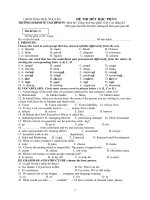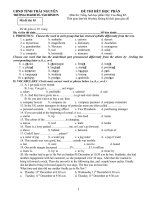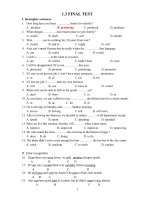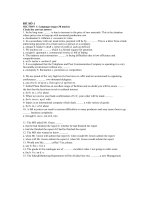Đề thi thử Ôn thi Tiếng Anh vào Cao Đẳng , Đại học năm 2016
Bạn đang xem bản rút gọn của tài liệu. Xem và tải ngay bản đầy đủ của tài liệu tại đây (534.82 KB, 24 trang )
Đề Thi Thử Tiếng Anh Có Hướng Dẫn Chi Tiết ___ Mai Lan Hương
ĐỀ THI THỬ VÀO ĐẠI HỌC VÀ CAO ĐẲNG MÔN TIẾNG ANH
Practice English Test for University and College Competitive Examination
ĐẠI HỌC NGOẠI THƯƠNG
BỘ GIÁO DỤC VÀ ĐÀO TẠO
ĐỀ CHÍNH THỨC
ĐỀ THI TUYỂN SINH ĐẠI HỌC NĂM 2015
Môn: TIẾNG ANH; Khối D
Thời gian làm bài: 90 phút, không kể thời gian phát đề
ĐỀ THI GỒM 80 CÂU (TỪ QUESTION 1 ĐẾN QUESTION 80)
I. Mark the letter A, B, C, or D on your answer sheet to indicate the correct
answer to each of the following questions.
Question 1: Neil Armstrong was the first man ______ on the moon.
A. to walk
B. walking
C. walked
D. has walked
Cấu trúc: the first/second/ /next/last/ youngest + (N) + to V
Question 2: Our industrial output______ from $2 million in 2002 to $4 million this
year.
A. rises
B. has risen
C. was rising
D. rose
Trạng từ "this year" => Động từ trong câu này phải chia ở thì hoàn thành (hành động
bắt đầu trong quá khứ và kéo dài đến hiện tại) => chọn B.
Question 3: ______ Serbia defeated Germany surprised everyone.
Đề Thi Thử Tiếng Anh Có Hướng Dẫn Chi Tiết ___ Mai Lan Hương
A.Whether
B. When
C. Because
D. That
- Loại ngay B và C vì khi đó câu thiếu chủ ngữ của động từ "surprised".
- Mệnh đề bắt đầu bằng "That/Wh-/Whether" có thể đóng vai trò là chủ ngữ trong câu.
Vậy B và D đều có thể được dùng đúng ngữ pháp trong câu này (khi đó "surprised" là
động từ chính trong câu). Tuy nhiên chúng ta cần xét nghĩa của chúng.
That Serbia defeated Germany surprised everyone. = The fact that Serbia defeated
Germany surprised everyone.
Dịch: Việc Seria đánh bại Đức khiến tất cả mọi người đều ngạc nhiên.
Whether Serbia defeated Germany surprised everyone. = Whether Serbia defeated
Germany or not surprised everyone.
Dịch : Seria có đánh bại Đức hay không cũng đều khiến mọi người ngạc nhiên.
=> That hợp lí hơn. => chọn D
Question 4: Even if you are rich, you should save some money for a ______ day.
A. windy
B. rainy
C. foggy
D. snowy
Cụm từ cố định : save/ keep something for a rainy day (để dành thứ gì đó phòng lúc
thiếu thốn)
Question 5: Laura had a blazing ______ with Eddie and stormed out of the house.
A. gossip
B. chat
C. word
D. row
Dịch : Laura có 1 cuộc cãi nhau nảy lửa với Eddie và sau đó lao thẳng ra khỏi nhà.
Question 6: All students should be ______ and literate when they leave school.
A. numerate
B. numeric
C. numeral
Đề Thi Thử Tiếng Anh Có Hướng Dẫn Chi Tiết ___ Mai Lan Hương
D. numerous
Chúng ta thấy có động từ "be" => chỗ trống cần điền 1 tính từ. Nhưng cả 4 đáp án đều
là tính từ. Khi đó chúng ta phải xét nghĩa của chúng.
- numerate : giỏi toán
- numeric = numerical : bằng số
- numeral : (thuộc) số (numeral (n) : số, chữ số)
- numerous : nhiều, đông đảo
=> chọn A
Dịch: Tất cả học sinh cần biết đọc biết viết và biết làm toán khi rời ghế nhà trường.
Question 7: ______ broken several world records in swimming.
A. She is said that she has
B. People say she had
C. She is said to have
D. It is said to have
Cấu trúc câu chủ động: People say (that) + clause
Câu bị động : It is said that + clause
S + is said to + V
- A loại vì không đúng cấu trúc.
- B loại vì sai ngữ pháp. Thì quá khứ hoàn thành chỉ được dùng khi nhấn mạnh nó xảy
ra trước 1 hành động khác trong quá khứ. Nhưng ở đây "say" lại chia ở hiện tại đơn.
- D loại vì chủ ngữ của hành động 'have broken" không phải là "it" mà là "she"
=> chọn C.
Question 8: Bill: "Can I get you another drink?"
Jerry: "______."
A. Forget it
B. No, it isn't
C. No, I'll think it over
D. Not just now
Dịch: Bill: Tớ lấy cho cậu cốc nữa nhé?
Jerry: Ngay bây giờ thì không.
Question 9: Liz: "Thanks for the nice gift you brought to us!"
Jennifer: "______".
A. All right. Do you know how much it costs?
Đề Thi Thử Tiếng Anh Có Hướng Dẫn Chi Tiết ___ Mai Lan Hương
B. Not at all. Don't mention it.
C. Actually speaking, I myself don't like it.
D. Welcome! It's very nice of you.
Liz: "Cám ơn vì món quà cậu đã mang tới cho chúng tớ!"
A: Được rồi. Cậu biết nó giá bao nhiêu không?
B: Có gì đâu, nhắc tới làm gì.
C: Nói thực là bản thân mình cũng chẳng thích nó.
D: Hoan nghênh. Bạn thật tuyệt.
=> chọn B.
Question 10: She had to borrow her sister's car because hers was ______.
A. out of work
B. out of order
C. off work
D. off chance
- out of work : thất nghiệp
- out of order : bị hỏng
Question 11: Ben: "______"
Jane: "Never mind."
A. Congratulations! How wonderful!
B. Sorry for staining your carpet. Let me have it cleaned.
C. Thank you for being honest with me.
D. Would you mind going to dinner next Sunday?
Never mind : Đừng ngại => thường dùng để nói với ai đó không cần lo lắng về hoặc
làm việc gì đó vì nó không quan trọng hay bởi vì bạn sẽ là người thực hiện điều đó.
A: Chúc mừng! Thật là tuyệt vời.
B: Xin lỗi vì đã làm bẩn chiếc thảm. Tôi sẽ giặt sạch nó.
C: Cám ơn vì đã trung thực với tôi.
D: Cô có phiền đến dự bữa tối vào Chủ Nhật tới không?
=> chọn B.
Question 12: "You can go to the party tonight______ you are sober when you come
home."
A. as long as
B. as well as
Đề Thi Thử Tiếng Anh Có Hướng Dẫn Chi Tiết ___ Mai Lan Hương
C. as far as
D. as soon as
- as long as : miễn là ( = only if) => dùng trong câu điều kiện.
- as well as sth : cũng như là => dùng trong quan hệ bổ sung.
- as far as : xa bằng, xa như => trong quan hệ so sánh
as far as I know/ I can remember : Theo như tôi biết/ nhớ
as far as I am concerned : theo tôi, tôi nghĩ => dùng khi bày tỏ quan điểm cá nhân.
- as soon as : nhanh, sớm, ngay khi
=> chọn A
Dịch: Anh có thể đi đến bữa tiệc miễn là lúc về không say rượu.
Question 13: We ______with a swim in the lake.
A. gave in
B. cooled off
C. got out
D. took up
- give in : chịu khuất phục, nhượng bộ
- cool off : trở nên mát mẻ, làm mát
- got out : đi ra ngoài
- take up : tiếp tục, chiếm (chỗ, thời gian)
Trong trường hợp không biết nghĩa của các động từ kép (phrasal verbs) trên ta có thể
đoán bằng cách thấy có sự liên hệ giữa "cool" và "swim" ( Tuy nhiên việc đoán nghĩa
này không áp dụng cho tất cả các trường hợp vì nhiều khi phrasal verbs mang ý nghĩa
khác hẳn so với những thành phần tạo nên nó.)
Question 14: As the drug took ______, the boy became quieter.
A. action
B. influence
C. effect
D. force
Loại B và D vì "take" không đi với 2 từ này. Xét 2 từ còn lại.
- take action: tiến hành.
- take effect: bắt đầu có tác dụng, đưa vào áp dụng.
=> chọn C.
Dịch: Khi thuốc ngấm, thằng bé bắt đầu dịu đi.
Question 15: I've warned you many times ______the front door unlocked.
Đề Thi Thử Tiếng Anh Có Hướng Dẫn Chi Tiết ___ Mai Lan Hương
A. not leaving
B. won't leave
C. not to leave
D. don't leave
warn sb (not) to do sth : cảnh báo ai làm/ không làm gì.
Question 16: "The inflation rate in Greece is five times ______ my country," he said.
A. as high as that in
B. as much as
C. as many as that in
D. more than
Cấu trúc: twice/ three times + so sánh hơn/ so sánh bằng
- Xét về mặt kết hợp từ, chúng ta không dùng tính từ "much/many" bổ nghĩa cho danh
từ "rate" mà thường dùng "high/low"
- Hơn nữa trong cấu trúc so sánh 2 đối tượng được so sánh phải song song nhau.
Trong câu này 2 đối tượng được so sánh là tỉ lệ lạm phát ở Hi Lạp và tỉ lệ lạm phát ở
"đất nước tôi".
Căn cứ vào 2 điều trên thì chỉ có đáp án A là đúng.
Trong đáp án này : that = the inflation
Question 17: Is it true that this country produces more oil than ______ ?
A. any another country
B. any countries else
C. any other countries
D. any country else
- "else" chỉ đứng sau đại từ bất định => loại B và D.
- "any" không dùng trước "another" => loại A
=> chọn C.
Question 18: Not having written about the required topic, ______ a low mark.
A. the teacher gave me
B. I was given
C. the teacher gave
D. my presentation was given
- Vế trước của câu là mệnh đề giản lược V-ing. Ta biết động từ ở mệnh đề chính có
cùng chủ ngữ với động từ V-ing.
- Trong 4 lựa chọn thì chỉ có đáp án B là có chủ ngữ "I" có thể làm chủ ngữ của cả 2
Đề Thi Thử Tiếng Anh Có Hướng Dẫn Chi Tiết ___ Mai Lan Hương
mệnh đề và phù hợp về nghĩa.
=> chọn B.
Question 19: They're staying with us ______ the time being until they can afford a
house.
A. during
B. for
C. at
D. in
for the time being : tạm thời, trong lúc này
Question 20: We have bought extra food ______ our guests stay to dinner.
A. so that
B. when
C. if
D. in case
Dịch: Chúng tôi mua thêm thức ăn phòng khi các vị khách ở lại dùng bữa tối.
Question 21: The Internet has enabled people to ______ with each other more
quickly.
A. interconnect
B. interlink
C. interact
D. intervene
- interconnect (v): kết nối những thứ tương tự nhau (dùng cho vật/việc).
- interlink (v) : kết nối (thường dùng ở bị động và cũng dùng cho vật/ việc).
- interact (v) : tương tác, tiếp xúc với nhau (trong giao tiếp).
- intervene(v) : xen vào, can thiệp vào.
Question 22: Mr. Black: "I'd like to try on these shoes, please."
Salesgirl: "______"
A. By all means, sir.
B. That's right, sir.
C. Why not?
D. I'd love to.
- By all means : dĩ nhiên rồi
=> dùng khi muốn diễn tả bạn rất sẵn lòng khi người khác làm gì đó.
- That's right : đúng rồi, đúng vậy
Đề Thi Thử Tiếng Anh Có Hướng Dẫn Chi Tiết ___ Mai Lan Hương
=> dùng để khẳng định lại 1 thông tin gì đó.
- Why not?: Tại sao lại không nhỉ, được chứ
=> chấp nhận 1 lời đề nghị.
- I'd love to : Tôi rất thích
=> chấp nhận 1 lời mời.
Question 23: Margaret: "Could you open the window, please?"
Henry: " ______."
A. I am, of course
B. Yes, with pleasure
C. I feel sorry
D. Yes, I can
Yes, with pleasure (Vâng, rất sẵn lòng) : dùng khi diễn tả sự chấp nhận 1 lời đề nghị
Question 24: ______I might, I couldn't open the door.
A. However hard
B. As try
C. Try as
D. No matter
Try + as + S + may/might : mặc dù đã cố gắng
=> cấu trúc nhấn mạnh với "as", động từ được đảo lên trước mệnh đề.
Try as I might, I couldn't open the door.
= However hard I try, I couldn't open the door.
= No matter how hard I try, I couldn't open the door.
Question 25: Martha, Julia and Mark are 17, 19 and 20 years old ______.
A. independently
B. separately
C. respectively
D. respectfully
- respectively : lần lượt, tương ứng
- independently : độc lập
- separately : riêng rẽ
- respectfully : với sự tôn trọng
Question 26: ______he does sometimes annoys me very much.
Đề Thi Thử Tiếng Anh Có Hướng Dẫn Chi Tiết ___ Mai Lan Hương
A. What
B. When
C. How
D. Why
What he does = The thing which he does
Question 27: Since he failed his exam, he had to ______ for it again.
A. take
B. sit
C. make
D. pass
"take" và "sit" đều được dùng khi muốn nói tham dự 1 kì thi. Tuy nhiên, khi có giới từ
"for" đi kèm ta phải dùng "sit".
sit an exam = sit for an exam = take an exam
Question 28: If everyone ______, how would we control the traffic?
A. could fly
B. can fly
C. flies
D. had flown
Ta thấy động từ trong mệnh đề chính được chia theo cấu trúc : would + V
=> xác định đây là câu điều kiện loại 2 (điều kiện không có thật ở hiện tại, do đó phải
lùi xuống 1 thì thành quá khứ).
=> chọn A
Question 29: The captain as well as all the passengers ______ very frightened by the
strange noise.
A. have been
B. was
C. is
D. were
Động từ trong câu này phải chia theo chủ ngữ đầu tiên "the captain".
Tương tự: A together with B
A along with B
=> động từ theo sau cấu trúc trên được chia phụ thuộc vào A.
Hơn nữa ngữ cảnh trong câu này là quá khứ nên phải chọn "was".
Đề Thi Thử Tiếng Anh Có Hướng Dẫn Chi Tiết ___ Mai Lan Hương
Question 30: It is imperative ______ what to do when there is a fire.
A. he must know about
B. that everyone know
C. that he knew
D. we knew
Thức giả định với "imperative" => động từ chia ở dạng nguyên thể không "to" hoặc
"should + Vinf".
II. Read the following passage and mark the letter A, B, C, or D on your answer
sheet to indicate the correct answer to each of the questions from 31 to 40.
In the West, cartoons are used chiefly to make people laugh. The important feature of
all these cartoons is the joke and the element of surprise which is contained. Even
though it is very funny, a good cartoon is always based on close observation of a
particular feature of life and usually has a serious purpose.
Cartoons in the West have been associated with political and social matters for many
years. In wartime, for example, they proved to be an excellent way of spreading
propaganda. Nowadays cartoons are often used to make short, sharp comments on
politics and governments as well as on a variety of social matters. In this way, the
modern cartoon has become a very powerful force in influencing people in Europe
and the United States.
Unlike most American and European cartoons, however, many Chinese cartoon
drawings in the past have also attempted to educate people, especially those who
could not read and write. Such cartoons about the lives and sayings of great men in
China have proved extremely useful in bringing education to illiterate and semi-
literate people throughout China. Confucius, Mencius and Laozi have all appeared in
very interesting stories presented in the form of cartoons. The cartoons themselves
have thus served to illustrate the teachings of the Chinese sages in a very attractive
way. In this sense, many Chinese cartoons are different from Western cartoons in so
far as they do not depend chiefly on telling jokes. Often, there is nothing to laugh at
when you see Chinese cartoons. This is not their primary aim. In addition to
commenting on serious political and social matters, Chinese cartoons have aimed at
spreading the traditional Chinese thoughts and culture as widely as possible among
the people.
Today, however, Chinese cartoons have an added part to play in spreading knowledge.
They offer a very attractive and useful way of reaching people throughout the world,
regardless of the particular country in which they live. Thus, through cartoons, the
thoughts and teachings of the old Chinese philosophers and sages can now reach
people who live in such countries as Britain, France, America, Japan, Malaysia or
Australia and who are unfamiliar with the Chinese culture.
Until recently, the transfer of knowledge and culture has been overwhelmingly from
the West to the East and not vice versa. By means of cartoons, however, publishing
Đề Thi Thử Tiếng Anh Có Hướng Dẫn Chi Tiết ___ Mai Lan Hương
companies in Taiwan, Hong Kong and Singapore are now having success in
correcting this imbalance between the East and the West.
Cartoons can overcome language barriers in all foreign countries. The vast increase in
the popularity of these cartoons serves to illustrate the truth of Confucius's famous
saying "One picture is worth a thousand words."
Question 31: Which of the following clearly characterizes Western cartoons?
A. Originality, freshness, and astonishment.
B. Humour, unexpectedness, and criticism.
C. Enjoyment, liveliness, and carefulness.
D. Seriousness, propaganda, and attractiveness.
Câu 2 đoạn 1 : "The important feature of all these cartoons is the joke and the element
of surprise which is contained"
Câu 3 đoạn 2: " cartoons are often used to make short, sharp comments "
Question 32: Chinese cartoons have been useful as an important means of______.
A. educating ordinary people
B. spreading Western ideas
C. political propaganda in wartime
D. amusing people all the time
Đoạn 3 : " many Chinese cartoon drawings in the past have also attempted to
educate people, especially those who could not read and write."
Question 33: The major differences between Chinese cartoons and Western cartoons
come from their ______.
A. purposes
B. nationalities
C. values
D. styles
Xem thông tin đoạn 4.
Question 34: The pronoun "this" in paragraph 4 mostly refers to ______.
A. a propaganda campaign
B. a piece of art
C. an educational purpose
D. a funny element
Muốn biết từ "this" ở đây nói đến cái gì chúng ta phải đọc câu trước đó : "Often, there
is nothing to laugh at when you see Chinese cartoons. This "
Đề Thi Thử Tiếng Anh Có Hướng Dẫn Chi Tiết ___ Mai Lan Hương
Question 35: The passage is intended to present ______.
A. a contrast between Western cartoons and Chinese cartoons
B. an opinion about how cartoons entertain people
C. a description of cartoons of all kinds the world over
D. an outline of Western cartoons and Chinese cartoons
Ta có thể thấy rõ kết cấu 2 phần của bài đọc: phần đầu nói về hoạt hình của các nước
phương Tây, phần sau bắt đầu từ "Unlike most American " nói về hoạt hình của
Trung Quốc cò kèm theo sự so sánh với hoạt hình phương Tây. Như vậy mục đích
cuối cùng của 2 phần này là nói lên sự khác biệt giữa hoạt hình của phương Tây và
của Trung Hoa
Question 36: Which of the following could be the best title for the passage?
A. A Very Powerful Force in Influencing People
B. Cartoons as a Way of Educating People
C. Chinese Cartoons and Western Cartoons
D. An Excellent Way of Spreading Propaganda
Từ đáp án cho câu hỏi 35 ở trên có thể chọn được đáp án đúng cho câu hỏi này là C.
Question 37: In general, Chinese cartoons are now aiming at ______.
A. illustrating the truth of Chinese great men's famous sayings
B. bringing education to illiterate and semi-literate people in the world
C. spreading the Chinese ideas and cultural values throughout the world
D. disseminating traditional practices in China and throughout the worldNhìn qua thì
thấy chỉ có B và C là có vẻ hợp lí.
Tuy nhiên, chúng ta loại B vì "Chinese cartoons" chỉ nhằm giáo dục những người
trong phạm vi nước đó thôi chứ không hướng tới toàn thế giới.
C là đáp án đúng : "Chinese cartoons have aimed at spreading the traditional Chinese
thoughts and culture as widely as possible among the people."
Question 38: The word "imbalance" in paragraph 6 refers to ______.
A. the mismatch between the East cartoons and the West cartoons
B. the influence of the East cartoons over the West cartoons
C. the dominant cultural influence of the West over the East
D. the discrimination between the West culture and the East culture









